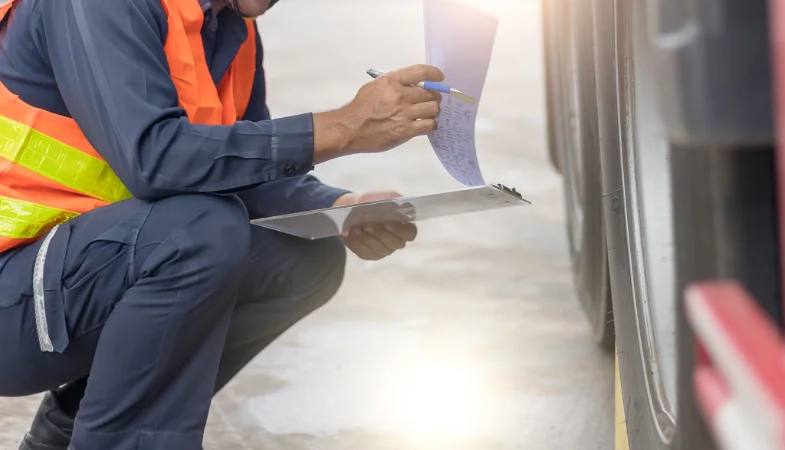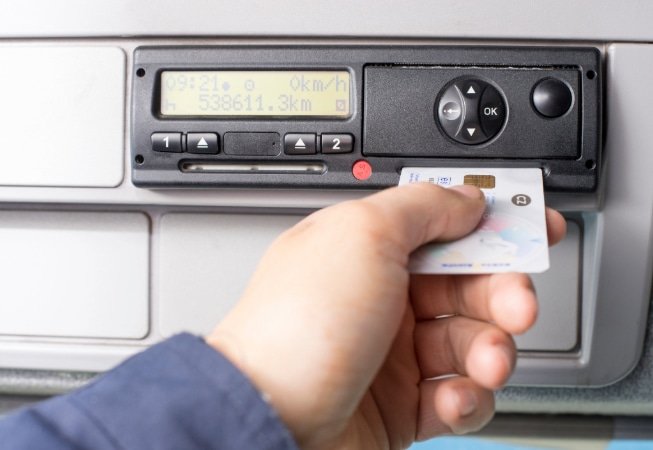Driver Walk-around Checks: The 10 Faults DVSA Expects You to Catch
Driver walk-around checks are a legal requirement and a vital safeguard for public safety. The driver is always legally responsible for the condition of the vehicle while in use and the walk-around check ensures vehicles are safe, roadworthy, and fit for purpose. Conducting a daily walk-around check to prevent avoidable accidents and injuries, avoid roadside prohibitions, minimise downtime, protect the public, and show compliance, is an important aspect of a driver’s role.
A minimum of one walk-around check must be conducted every day or at least once in a twenty-four-hour period that the vehicle is being used. Some vehicles may require multiple checks during the twenty-four-hour period.
When more than one driver uses the vehicle during the day’s operations, the driver taking charge of the vehicle needs to make sure it is roadworthy and safe to drive by carrying out their own walk-around check.
Drivers share the responsibility for the vehicle’s roadworthiness with the operator. They can be fined or prosecuted for roadworthiness offences found on vehicles if they are thought to be responsible.
Traffic commissioners can take action against a driver who does not complete a sufficient walk-around check. This could lead to a driver conduct hearing, which may result in the loss of the vocational driving licence.
The 10 Most Common Defects DVSA Inspectors Find
A well-maintained vehicle is less likely to suffer mechanical failure, reducing the risk of collisions caused by defective brakes, tyres, steering, or lighting systems. A vehicle not subject to daily walk-around checks is at risk of having one or more of the following defects:
Lamps and Indicators
You must check that all lights and indicators work correctly; all lenses are fitted, clean, and the right colour; and marker lights are fitted and working.
Brake Lights
You must ensure that stop lamps come on when you apply the service brake and go out when you release it.
Tyre Condition and Inflation
You should check that the tyres and wheels are secure; the tyres have a tread depth of at least 1mm; the tyres are inflated correctly; there are no deep cuts in the tyre’s sidewall; there is no cord visible anywhere on the tyre; and there are no objects or debris trapped between the twin wheels.
Wheel Nuts
You must check that all wheel nuts are tight enough. You can check if wheel nut indicators have moved to do this.
Mirrors and Windscreen
You must ensure that the windscreen is not cracked, scratched, or discoloured. Check that all mirrors are in place and not damaged or missing glass, obscured, or insecure.
Fluid
You should check that the fuel filler cap is fitted correctly. Turn on the engine and check underneath the vehicle for any oil, fuel, or coolant leaks.
Windscreen Wipers and Washer Fluid
You must make sure the windscreen wipers work, and check that they are not missing, damaged, or worn. Make sure the windscreen washer is working.
Bodywork, Doors, and Steps
You must check that cab mountings and tilt devices are secure; body panels are secure and not likely to fall off; all doors work as needed and are secure when closed; and steps are secure and safe to use.
Number Plates and Reflectors
You should check that the number plate is not broken, incomplete, incorrect, spaced incorrectly, dirty, faded, or covered over by anything. Check that the reflectors (including side reflectors) are not missing, broken, insecure, fitted incorrectly, the wrong colour, or obscured by dirt or other objects.
Trailer Coupling, Airlines, and Electrical Connections
You must check that couplings are free from debris and are in the right place; there are no leaks; there is no damage or wear to the brake lines; and the parking brake for the trailer works. After the first brake test, leave the engine running so pressure can build up. This will make it easier to hear any leaks as you carry out the rest of the walk-around check. Check each connection and make sure that; all visible wiring is insulated and not likely to get caught or damaged; all electrical trailer couplings are connected securely; and all electrical switches work correctly. Check that your vehicle is securely attached to your trailer and that the trailer is found correctly in the fifth wheel or coupling, and secondary locking devices are in the correct position.
A DVSA traffic investigation was carried out on an operator in February 2024, where the examiner found vehicles that had driver-reportable defects, several of which were presented with dangerous defects such as loose wheel nuts and tyre defects. The issues raised by this investigation were found to be the responsibility of the transport managers, one of which was disqualified from acting as a transport manager for a period of one year and until he sat and passed again the transport manager certificate of professional competence.
How to Record and Report Defects
You must record and report all defects, or symptoms of defects, that could prevent the safe operation of the vehicle, that you find during the daily walk-around check or become aware of during your journey, as part of the vehicle’s maintenance system.
To conduct a daily walk-around check, it is common practice to use a composite form that includes a list of the items that are checked each day. Where practical, the system should incorporate ‘nil’ reporting when each driver makes out a report sheet or confirms by another means that a daily check has been carried out, and no defects have been found. This is good practice as it is a useful means of checking that drivers are carrying out their duties, and these forms can be used for audit purposes. It is recommended that ‘nil’ defect reports are kept for at least three months.
To report defects, you should record the vehicle registration or identification mark, the date, details of the defects or symptoms, your assessment of the defects, your name, and who you have reported the defect to.
The report must include how defects were rectified before the vehicle is used and must be kept available for fifteen months along with any assessment, the rectification work, and repairer.
Defect-to-Rectification Trail
Any defects found during the daily walk-around check, while the vehicle is in use or on its return to base, must be the subject of a written report by the driver or some other person responsible for recording defects.
All drivers’ defect reports must be logged with a responsible person with sufficient authority to ensure that the appropriate job is raised. This might include taking the vehicle out of service.
Operators should ensure that adequate maintenance resources are available to confirm the rectification of the reported defects before the vehicle is used.
Conclusion
Our Driver Defect App makes daily walk-around checks and driver defect reporting quick, easy, and compliant. Drivers can complete inspections from their mobile app, with time-stamped records, photo uploads, and instant roadworthiness confirmation.
Any defects are flagged immediately and sent to the workshop for action, keeping repairs on track. Every check is stored securely against the vehicle for a complete audit trail.
You can learn more about daily walk-around checks on our website or download a walk-around checklist here.





